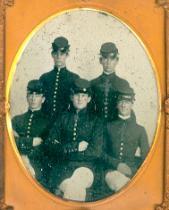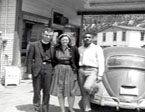Find Your VMI Ancestor

Search Our Online Historical Rosters
The VMI Archives receives many inquiries from family historians seeking information about a VMI ancestor. The first step is to search our historical rosters. Have a question not answered here? For additional information, contact the VMI Archives
Ancestor Research FAQ
The database contains the names of all students who attended VMI from the opening of the Institute in 1839 through 1945; some historical faculty and staff members; and non-alumni who were sent to VMI for training during World Wars I and II. Many 19th and early 20th century roster records also contain a biographical summary. Once you identify an ancestor, contact us for additional available records. Please note that we do not release information about living individuals.
One of our most popular and valuable resources is our collection of 19th and early 20th century biographical files. A file exists for every early alumnus--both graduates and non-graduates, as well as for early faculty and staff members. A typical cadet record consists of correspondence from parents regarding a cadetship; correspondence from the alumnus; alumni questionnaires, often containing genealogical information; and obituaries and other clippings. Family historians can frequently locate a wealth of information about VMI ancestors. In addition to the items listed above, the files of Civil War veterans may include documents pertaining to war service, often in the form of letters or biographical information submitted at the request of the Institute.
Our early cadet records often contain one or more surveys sent to an alumnus or descendant in the early 20th century. These surveys asked for family genealogy as well as biographical data such as date of birth, post-VMI career and other details. We frequently have names of parents, grandparents and, sometimes, even great-grandparents.
If you don't find a name in the online rosters, contact us and we will double check our physical records. Our enrollment records are very complete and we are confident that we can document VMI enrollment. Family oral history is a valuable tool for starting your research, but it is not always accurate. Your ancestor may have attended another military college, or a military secondary school, or served in the military; or he may have applied to but not actually attended VMI.
VMI uses the "Class of" designation to refer to the group with which a cadet matriculates and to the individuals within that group. A cadet entering in the Fall of 1854 became a member of the Class of 1858; this Class identification is used whether or not the student continued until graduation. Think of "Class" in terms of a descriptive label rather than graduation status.
VMI was never a secondary school. The Institute, opened in 1839, was the first state-supported military college in the United States and it has never offered high school level classes. Numerous military secondary schools were established throughout the South during the 19th century, but these prep schools were not part of or affiliated with the Institute.
The application process during the 19th century did not include the kind of formal application document with which we are familiar today. Rather, it typically consisted of correspondence between the school and parents, as well as gathering letters of recommendation for consideration by the VMI Board of Visitors. We often have correspondence in our files relating to the admission process and cadetship of individuals. For information about a specific person, please contact us.
We have a very extensive photograph collection, which can be searched online. Individual photographs exist from the 1850's forward, although not of every cadet. Class group photos first became popular in the 1870's, but were typically taken only during the First Class (Senior) year. The first yearbooks were not published until the late 19th century. In short, we have many cadet photographs, but do not have a photograph of every cadet. If you have a question, please contact us.
The VMI class system is: Fourth Class = Freshman, Third Class = Sophomore, Second Class = Junior, First Class = Senior. In the 19th century, it was relatively common for well-prepared students to enter the Institute as a "third". A "Rat" is the nickname for new cadets; the term was first used in the mid-19th century.
Non-historical alumni records are closed to research. Records of living alumni are covered by FERPA and privacy statutes. We do not release the records of living alumni. The only exception is when the alumnus has provided us with written permission specifically authorizing release to a third party.
.svg)
.png)
